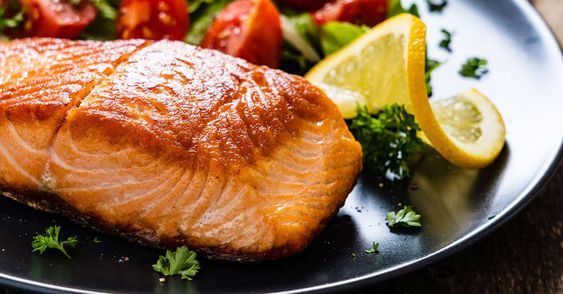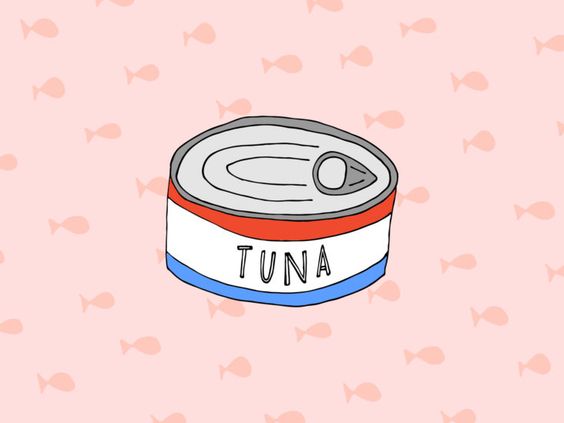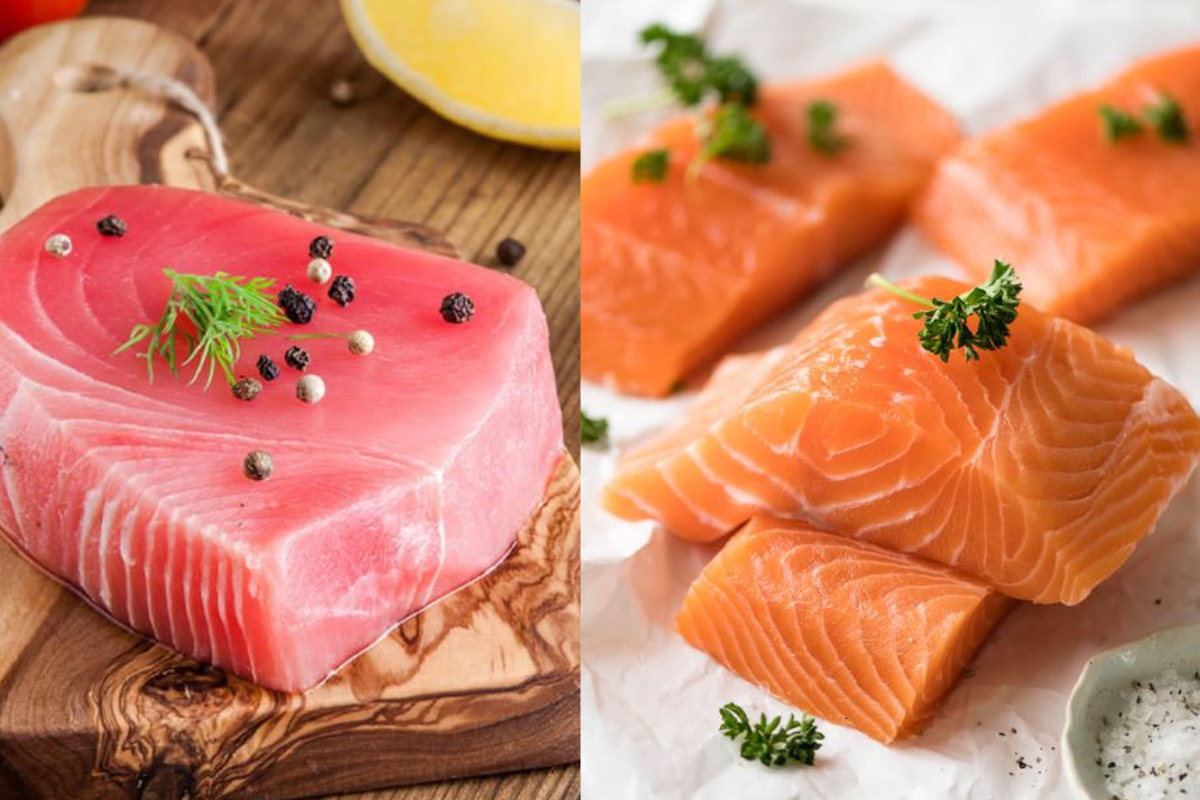When it comes to seafood favorites, tuna and salmon are the reigning champs. Whether you’re ordering sushi or grilling up a summer feast, these two fish always manage to steal the spotlight. But which one truly deserves the crown? Let’s dive into the delicious world of tuna and salmon to see how they stack up in terms of taste, nutrition, environmental impact, and more.
Tuna and Salmon 101: The Basics
Tuna and salmon are seafood superstars, each with their own unique charm. Tuna, known for its lean and meaty texture, is a migratory fish found in the warm waters of the Atlantic, Indian, and Pacific Oceans. You’ve likely heard of Bluefin, Yellowfin, and Albacore – some of the most popular tuna varieties. On the other hand, salmon prefers the chilly waters of the North Atlantic and Pacific Oceans. Whether it’s Sockeye, Coho, or Chinook, salmon is famous for its rich, buttery flavor and soft texture. Both are protein-packed powerhouses often used in dishes ranging from sushi rolls to grilled filets.
Nutritional Battle: Tuna vs. Salmon
Both tuna and salmon are nutritional gems, but they shine in different ways. Tuna is the go-to for anyone looking to up their protein intake without adding too much fat. It’s lean, low in calories, and an excellent post-workout snack. But heads up – tuna is also higher in mercury compared to salmon.
Salmon, on the other hand, is packed with omega-3 fatty acids, which are amazing for heart health. Plus, it has more vitamin D and calcium than tuna, making it a well-rounded option for overall health. Here’s a closer look at their nutritional profiles per 100g:
| Nutrient | Tuna (Raw) | Salmon (Raw) |
|---|---|---|
| Calories | 132 kcal | 206 kcal |
| Protein | 28.0 g | 22.0 g |
| Fat | 0.6 g | 13.0 g |
| Saturated Fat | 0.1 g | 2.0 g |
| Cholesterol | 42 mg | 63 mg |
| Calcium | 39 mg | 12 mg |
| Iron | 1.0 mg | 0.8 mg |
| Potassium | 268 mg | 363 mg |
| Omega-3 Fatty Acids | 0.1 g | 2.6 g |
Nutritional Highlights:
- Calories: Salmon is more calorie-dense than tuna, making it the heartier option.
- Protein: Tuna takes the crown here with more protein per 100g.
- Fat: Salmon is higher in fat, but it’s the good kind – those heart-loving omega-3s.
- Omega-3s: Salmon wins big with its omega-3 content, while tuna is a bit lacking in this department.
Taste & Texture: What’s Your Vibe?
If you’re all about that firm, steak-like texture, tuna is your guy. Its meaty, mild flavor makes it perfect for grilling or searing, and it holds up well in hearty dishes. Think of tuna as the red meat of the sea – satisfying and versatile.
Salmon, on the other hand, is your buttery, flaky friend. Its rich, melt-in-your-mouth texture pairs beautifully with both sweet and savory flavors. Whether you’re baking, smoking, or poaching, salmon’s silky smoothness always delivers.
Environmental Impact: Who’s Greener?
If you’re eco-conscious, you might want to dig a little deeper into how tuna and salmon are sourced. Tuna, particularly Bluefin, has gotten a bad rep due to overfishing and bycatch (catching unintended species like dolphins). The sustainability of tuna can vary, so keep an eye out for eco-friendly labels, like those from the Marine Stewardship Council.
Salmon fishing is a mixed bag, too. Wild-caught salmon is generally more sustainable, but farmed salmon can raise some environmental red flags like habitat destruction and pollution. If you’re leaning toward salmon, try to go for wild-caught or responsibly farmed options.

Culinary Showdown: Recipe Ideas
When it comes to versatility in the kitchen, both tuna and salmon are stars. Tuna is a fan favorite in sushi and sashimi, and it’s equally delicious when seared or canned for salads and sandwiches. Salmon, with its rich flavor, is perfect for smoking, grilling, or baking. From classic smoked salmon bagels to grilled salmon with a tangy dill sauce, this fish adds a gourmet touch to any meal.
Health Benefits: The Good and the Bad
Both of these fish are packed with health benefits, but there are a few things to keep in mind. Tuna is a lean, mean protein machine, rich in selenium and vitamin B12, but it’s higher in mercury, which can be a concern for pregnant women and kids. On the other hand, salmon’s high omega-3 content can reduce inflammation and boost heart health, but if you’re opting for farmed salmon, be cautious of potential contaminants.
Canned Tuna vs. Canned Salmon: Which is Better?
When it comes to pantry staples, canned tuna and canned salmon are both winners. But which one should you choose? Let’s break it down quickly.
Nutrition:
- Canned Tuna: Low in calories and fat but high in protein. Great for lean meals but contains more mercury.
- Canned Salmon: Higher in omega-3s and packed with calcium (thanks to those soft bones). It’s a bit richer in flavor and nutrients but also higher in fat.
Taste & Texture:
- Tuna: Mild, flaky, and super versatile. Perfect for salads and sandwiches.
- Salmon: Richer, with a stronger flavor. Ideal for heartier dishes like fish cakes or salmon patties.
Environmental Impact:
- Tuna: Overfishing concerns exist, but choosing skipjack or sustainably caught options helps.
- Salmon: Wild-caught varieties are usually more sustainable, though farmed salmon can be a bit more controversial.
Price:
- Tuna: Generally more affordable.
- Salmon: Pricier, especially wild-caught, but offers more nutrients.
The Bottom Line:
Go for tuna if you want a budget-friendly, lean protein source. Opt for salmon if you’re looking for heart-healthy fats and a nutrient boost.
Quick FAQs:
- Is tuna healthier than salmon? Salmon has more omega-3s and calcium; tuna is leaner.
- Why is salmon more expensive? It’s usually wild-caught and packed with more nutrients.
- Can I eat tuna daily? Due to mercury, limit tuna to 2-3 servings per week.
Both have a spot in your pantry depending on your goals!

The Verdict: Tuna or Salmon?
At the end of the day, both tuna and salmon have their own set of pros. If you’re looking for a lean, high-protein option that’s lower in calories, tuna is your best bet. But if you’re after those heart-healthy fats and a more nutrient-dense fish, salmon takes the win. It all depends on your taste, nutritional needs, and how you plan to cook them.
On the topic:
Trout vs Salmon: Key Differences
Cottage Cheese vs Greek Yogurt: A Nutritional Comparison
Veal vs Beef: Nutrition, Flavor & Cooking – Your Go-To Guide!
FAQs:
Is tuna healthier than salmon?
Tuna is leaner and lower in calories, but salmon packs more omega-3s and essential nutrients like vitamin D. Both are healthy, it just depends on what you’re looking for!
Is tuna more expensive than salmon?
Depends on the variety and sourcing, but Bluefin tuna can be pricier than salmon, especially when it comes to sushi-grade cuts.
Why is tuna considered one of the healthiest fish?
Tuna is high in protein and low in fat, making it a great option for those looking to build muscle or maintain a lean diet.
Can I eat tuna but not salmon?
Absolutely! But keep in mind that while tuna is a great lean option, it has higher mercury levels, so it’s best to enjoy it in moderation. Salmon, especially wild-caught, is often a safer bet for regular consumption.

